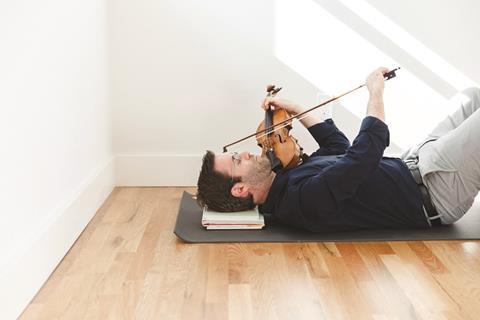Exercises to release tension and improve ease of movement when playing the violin by Tomas Cotik, violin professor at Portland State University

The following is an extract from a longer article in The Strad December 2017 – to read it in full, download the issue on desktop computer or via the The Strad App, or buy the print edition
When you practise these exercises, make sure that your breathing is continuous and that you are well grounded, with flexible knees, relaxed gluteal muscles and an awareness of your feet on the floor. To begin, put down your instrument and rotate first your hips and then your upper body, to make sure everything is loose. When you start to play, it can be helpful to walk around; or, if you are sitting, try sitting on the edge of the chair, feel your sitting bones against the surface and make sure your legs are free. Look at a model of the human skeleton to give you a better understanding of how the body works. Did you realise, for example, that the finger bones begin at the wrist joint, not where the finger joins the hand? Being aware of your body’s different components while you play can give you a lot more freedom and endurance. Many of the technical problems we experience stem from unnecessary tension and bad habits.
RAISED SHOULDERS
If your shoulders shoot up when you encounter something difficult in the music, or when you try to play expressively:
- Put your instrument down and fold your arms
- Let your arms fall to your sides, relaxed, with a slap
- Repeat this action until you have let go completely
- Remember this feeling, and try to play the passage again
The following exercise (pictured above) is excellent for learning how it feels to play with low, relaxed shoulders, but only try it for a few minutes at a time, and be careful not to break your bow!
Lie down with your back on the floor, a few books under your head, your knees bent and hip-width apart, and your violin and bow within reach. Place your hands on your tummy, with your fingers extended, and think of your body lengthening and widening in opposing directions from the joints – imagine that there is more room in the joints, but don’t actually move anything. Be aware of every part of your body. Without getting up, pick up your violin and try to play it. This is very awkward to begin with, and it can feel a bit as though you’re playing on the Moon, but it is a very good exercise because it becomes almost impossible to raise your shoulders. It also helps the lower back to relax and straighten.Another idea, when playing standing up, is to hang a handbag or violin case over each shoulder. If you do that, you will notice if you raise your shoulders by even a millimetre!
To read the full article by Tomas Cotik with several recommended exercises, download The Strad’s December 2017 issue on desktop computer or via the The Strad App, or buy the print edition
Special thanks to Lauren Schiff, Alexander Technique faculty member of The Juilliard School for her advice and insights on this article.



































1 Readers' comment